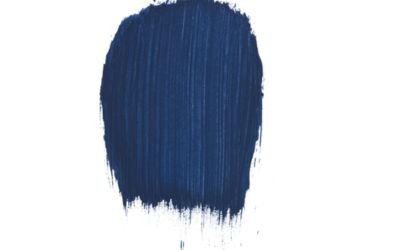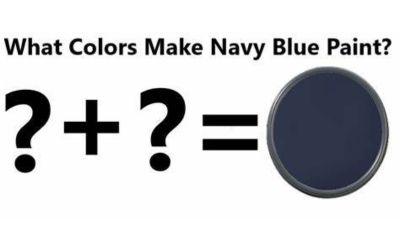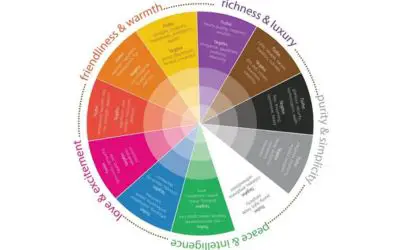You can take various approaches to arrive at navy blue paint. The most preferred bases of blue paint are cerulean blue, ultramarine blue, and Prussian blue paint.
However, any blue paint can work. You can then mix the base color with black or orange paint.
Mixing blue and black paints is the most common way of creating navy blue paint.
Slowly and cautiously add the black paint while stirring until you arrive at your desired shade. If you don’t have black paint, here is a detailed guide to learning what colors make black when mixed.
This article will teach you how to make navy blue paint using a blue base.
You will also learn a plethora of navy blue color combination ideas, such as navy blue and gold, that can add depth, personality, and style to any design or space.
Let’s get started.
What Is Navy Blue, Anyway?

Navy blue is generally a darker hue of blue. As the name suggests, navy blue is often associated with the military.
However, it is quite versatile and can be used in many contexts. Navy blue paint offers a bold, more subdued look in clothing, cars, and home decor.
Navy Blue’s hex code is #000080, with a lightness value of about 25%. In other words, navy blue is a dark and highly saturated color.
It is a timeless color that will not go out of style. As you shall learn below, some ideas for navy blue include using it in virtual reality (VR) to design immersive environments.
Here is a guide on navy vs midnight blue color.
First Things First: How to Make Blue Color
You might need to arrive at a navy blue color, but you don’t have blue paint in your toolkit.
In that case, you should consider making a blue color first. It depends on the colors in your repository.
The best colors for creating true blue paint are cyan and magenta. Mix them in a ratio of 1:1.
If you don’t have the greenish-blue cyan and the purplish-red magenta, make a blue color using a blue pigment.
Mix blue pigments like cobalt blue, ultramarine blue, and cerulean blue. Each can be bound using gum Arabic in a ratio of 1:1 to obtain blue paint.
Note that it is easier to add pigments in bits than it is to remove excess pigment.
So, add small amounts of pigments. Also, test the blue color on a scrap piece of paper before using it on your navy blue paint project to ensure it is the shade you want.
Other ways of creating a blue color include using natural dyes that produce blue colors, such as lac, indigo, and woad.
You can also use food coloring to create your desired shade of blue.
Add the blue food coloring in little bits to water or milk and stir to achieve your desired intensity.
What Colors Make Navy Blue?

Navy blue results from various color combinations, including blue and black or blue and orange paint.
You can also make navy blue by mixing different colors of dye or ink.
The most simple and popular way is mixing blue and black paint. Cerulean blue or ultramarine blue are common base color choices.
Add the base color into a container and pour the black pigment a little bit at a time while stirring.
Black is a neutral color that will absorb most of the visible light in the blue paint until you reach the desired navy blue shade.
The second but less popular way to make navy blue paint is by mixing blue with orange paint.
Unlike black paint, orange paint may produce a more vibrant shade of navy blue.
Still, you should add the orange paint bit by bit to reach your desired navy blue hue.
Mix three parts ultramarine blue paint with 1 part black paint or three parts blue paint with 1 part orange paint.
It is also worth noting that you can make navy blue paint from indigo dye.
Here is a guide in navy vs indigo colors.
Indigo dye is a versatile dye that can achieve various shades of blue. One part of the dye mixed with 1 part of water produces a deep blue color.
Mix the resulting color with 1 part binder like gum Arabic to get navy blue.
A Brief Intro to Color Theory
Color theory examines how colors work together to appeal to the human mind.
Understanding color theory is critical for creating effective and visually appealing designs. Fashion, interior, and graphic designers can find it relevant and stylish.
Color theory has essential concepts like color harmony, hue, saturation, and lightness. Color harmony is how well different colors work together.
You can create harmonious colors using a single hue (monochromatic) or colors next to each other on the color wheel (analogous harmony).
Designers can also create color harmony using complementary, split-complementary, or triadic harmony.
In contrast, color hue is determined by the wavelength of light. Shorter wavelengths produce warmer colors, while longer wavelengths create cool colors.
Generally, hue refers to color names like red, blue, or green. The hues can also be more or less bright and saturated.
Color theory has many applications.
It can be used to create mood or atmosphere. For instance, cool colors like blue and green could be used in interior design or graphic design to create a sense of calm and relaxation.
On the other hand, warm colors like red and orange exude energy and excitement.
Color theory is also essential for drawing attention to specific elements of your design, creating contrast, balance, and unity.
These can make clothes, rooms, logos, and websites appear more orderly, visually appealing, and cohesive.
For instance, fashion designers could use hues to make cloth wearers stylish and flattering.
Clothes of cool colors like blue, green, or violet can make a person look more slim while warm colors can make someone look more tan.
3 Categories of Colors in the Color Wheel
The color wheel is a diagram that relates different colors.
It can help you understand the connection between colors and how to use them to achieve various effects like harmony, mood, and contrast.
The wheel’s color categories are primary, secondary, and tertiary colors.

Primary colors
Primary colors are the basis of all the colors in existence. In other words, you cannot create them by mixing any other colors.
The three primary colors are red, yellow, and blue. The first two are warm colors, and blue is a cool color.
We associate primary colors with various things. For instance, red can signify energy, excitement, and passion, while yellow is associated with creativity, optimism, and happiness.
On the other hand, blue is associated with calmness, peace, and tranquility.
Secondary colors
Isaac Newton was the first physicist and mathematician to identify secondary colors due to his interest in optics and color theory.
You can get secondary colors by mixing two primary colors. They are powerful colors for creating visually appealing and effective effects.
The three secondary colors are green, orange, and violet. Green is obtained by mixing blue and yellow; orange is created by mixing yellow and red; and violet is created by mixing blue and red.
Orange is warm, while violet and green are cool secondary colors.
Green signifies many things, including nature, freshness, and growth. Violet is associated with magic, mystery, and spirituality.
However, orange can mean creativity, enthusiasm, and energy.
Tertiary colors
If you mix a primary color, say red, and a secondary color, say orange, the result is a tertiary color.
In that case, the tertiary color is red-orange. You can create six tertiary colors from the primary and secondary colors.
The tertiary colors are red-orange, yellow-orange, yellow-green, green-blue, blue-violet, and red-violet.
They offer significant variety in moods and emotions, as they can depict warmth, coolness, excitement, and calmness.
Black and White Colors
Technically, black and white are not considered colors. The former absorbs all visible light, thus considered the absence of color.
Unlike black, white reflects all visible light. So, white is technically the presence of all colors. Black and white help create a sense of contrast in the color spectrum.
For instance, a white dress makes a person look elegant, and a black-and-white photo can be particularly striking.
Black and white can also portray mystery or suspense. Interior designers can use white in a room to make it feel spacious, cold, and empty.
Black and white can also interact with other spectrum colors to emphasize those colors, subtract them, or inject neutrality into a design.
They can create a dramatic effect, make images stand out more, and create a more muted or somber effect.
Why Orange Works in Deepening Blue Paint
Orange has a long wavelength and high color saturation and is the complementary color of blue.
For these reasons, it works in deepening blue paint and adding a little orange to blue paint results in a darker, richer blue color.
Being complementary means orange is on the opposite side of blue in the color wheel.
When complementary colors are mixed, they create a neutral color. The orange pigment absorbs blue light, leaving a dark brown or black light to be reflected.
It also deepens blue paint because it has a long wavelength. Being bright and cheerful is critical to offsetting the cool blue paint and making a more navy blue color.
Orange is also highly saturated. That means it has a high color value, essential in deepening blue paint and creating a more intense hue.
In addition, the orange color is bright. Its ability to reflect more light can make blue paint appear darker and more dramatic.
What If You Don’t Have a Blue Paint?
Perhaps you want to make navy blue paint but don’t have blue paint. Don’t worry.
You can use other color combinations like mixing black and cyan, black and royal blue, or black and ultramarine blue.
Note that the paint’s quality will affect the quality of the navy blue you create.
- Mix black and cyan: Cyan is close to true blue in the color wheel. In subtractive color mixing, black plus cyan results in a navy blue of dark blue paint. You will need two parts of black paint and 1 part of cyan paint. Pour the black into a mixing container and add the cyan to the blue paint a little at a time. Mix them until you get a navy blue color.
- Green, magenta, and black: You can start by creating blue paint from green and magenta. Mixing the two colors results in blue, which is more of a turquoise color. You can use it to make navy blue by adding a small amount of black.
- Cyan and magenta: Mixing these primary colors results in blue color. You can derive navy blue without needing additional paints. With the knowledge on what colors make cyan blue and magenta, adjust the amount of each depending on the desired navy blue paint’s lightness or darkness.
- Mix black and royal blue: If you don’t have blue paint, check for its shades, such as royal blue or ultramarine blue. Start by mixing equal parts of black and royal blue or ultramarine blue. Darken the shade of navy blue by adding more black, and make it lighter by adding blue shades.
Making Navy Blue Tint: The Experiment

Although you can purchase navy blue paint from a store, it is also possible to make it at home.
It is a deep, rich blue that is elegant and sophisticated, often used in home decor, fashion, and art.
Things You’ll Need
To make navy blue paint at home, you need the following supplies:
- Royal blue paint
- Black paint
- A mixing container
- A stirring stick
- White paint for a lighter navy blue (optional)
- Yellow paint for a warmer navy blue (optional)
6 Steps To Making Navy Blue Paint
Follow the steps below to make navy blue paint;
1. Select the mixing container and gather supplies
Choose a suitable mixing container that can comfortably hold the desired quantity of paint.
It should be clean, sturdy, and large enough to accommodate the mixing process without spills.
Gather the royal blue paint, black paint, a stirring stick, and optionally white and yellow paint for further color customization and adjustments.
2. Measure and pour royal blue paint
Having a specific measurement allows for consistency and easier replication.
Measure the desired amount of royal blue paint based on your project’s size and requirements.
Carefully pour the royal blue paint into the mixing container, ensuring you scrape the container’s sides to collect every drop.
If you are interested in how to make royal blue acrylic paint, find shades of ultramarine blue, alizarin crimson or magenta, and cyan blue.
3. Add black paint to create depth
Add black paint to the mixing container gradually to darken the royal blue paint and achieve a navy blue shade. Start with a small amount and adjust as needed.
For instance, adding one teaspoon of black paint per cup of royal blue paint can be a starting point.
Stir the mixture using the stirring stick, ensuring the colors blend evenly. Take note of the proportions used to replicate the desired shade in the future.
4. Optional: Lighten the navy blue with white paint
Add a small amount of white paint to the mixture, then stir it thoroughly to incorporate the color. This is an optional step, but you can still learn what colors make white.
Gradually increase the amount of white paint until the desired lightness is achieved.
Be cautious not to add too much white paint, as it may shift the color towards a pale instead of navy blue.
5. Optional: Add yellow paint for a warmer tone
You can add yellow paint to the mixture to introduce a warmer undertone to your navy blue.
Begin with a small quantity and carefully incorporate it into the existing paint mixture.
Stir the paint thoroughly to ensure an even distribution of color.
Gradually increase the amount of yellow paint until the desired warmth is achieved.
Pay attention to the color transformation and adjust to avoid an overpowering greenish hue.
6. Thorough mixing and testing
After incorporating any optional colors, thoroughly mix the entire content in the container.
Use the stirring stick to blend the colors uniformly without leaving any visible streaks.
Apply a small amount of navy blue paint to a test surface or canvas to evaluate the color accuracy.
Allow it to dry completely to observe the final shade. If necessary, make adjustments by repeating the steps above until you’ve achieved the desired navy blue color.
Ideas For Using Navy Blue In Designs or Paintings
Here are some ideas;
Virtual reality environments
Step into virtual reality (VR) by designing immersive environments where navy blue takes center stage.
Using VR technology, create a digital world where every aspect, from the sky to the landscape, is saturated in stunning navy blue hues.
Imagine a vast virtual cityscape with buildings, streets, and even an atmosphere adorned with navy blue elements.
Users can explore and interact with this virtual navy blue world, experiencing a heightened sense of wonder and serenity.
The ability to navigate through a fully immersive navy blue environment would offer a unique artistic experience, pushing the boundaries of traditional paintings and designs.
Nano-particle paintings
Embrace the wonders of nanotechnology in the creation of navy blue paintings that truly captivate the observer.
Incorporate specially engineered navy blue nano-particles into your paint, which possess unique reflective properties.
The nano-particles would react to changes in light and perspective, creating a dynamic visual effect on the canvas.
For instance, as the viewer moves, the navy blue paint shifts in tone and intensity, offering an ever-changing visual experience.
You can create a large-scale painting with an intricate navy blue pattern that shimmers and transforms as one moves around it.
Using nano-particles would add a futuristic and mesmerizing quality to the navy blue artwork.
Navy Blue Color Combo Ideas
Navy blue offers a plethora of color combination ideas that can add depth, personality, and style to any design or space.
- Navy blue and orange: This complementary color scheme creates a striking contrast and a warm balance. Orange adds a touch of energy and brightness to the dark and cool navy blue. You can use a medium-tone shade of orange, such as tangerine or papaya, for a bold and colorful look.
- Navy blue and gold: Navy blue and gold: This is a glamorous and traditional color scheme that always remains the same. Gold adds a regal and elegant touch to the classic, cozy navy blue. You can use metallic gold accents, such as hardware, lighting, or wall art, to make any space look more luxurious and refined.
- Navy blue and brights: This fun and lively color scheme evokes an energetic mood. Bright colors, such as lime green, lemon yellow, coral, or turquoise, lighten the navy blue and give it a lively lift. You can use these colors in patterns, such as florals, stripes, or geometrics, to add interest and variety to your navy blue-themed rooms.
Energetic Colors To Pair With Navy
Energetic hues complimenting navy blue include red, orange, yellow, green, purple, pink, white, silver, and gold.
Blue pink mixed create beautiful shades depending on the proportions of the two colors.
These vibrant combinations can evoke various moods and atmospheres, ranging from playful and fun to elegant and refined.
For a bold and eye-catching statement, pair navy blue with red. Opt for navy blue and orange to add a touch of personality and whimsy.
Create a bright and cheerful ambiance with navy blue and yellow.
Depending on the intensity and richness you want, you can use various shades of yellow, such as butter yellow, mustard yellow, lemon yellow, or gold.
Achieve a refreshing and modern feel with navy blue and green, or pair navy blue with purple for a sophisticated and regal touch.
You can also infuse a feminine and delicate atmosphere by pairing navy blue with pink or create a timeless and stylish navy blue and white look.
Lastly, embrace luxury and elegance by combining navy blue with gold.
Calming Paint Colors To Use With Navy Blue
Some calming paint colors for the navy are soft gray, pale blue, light beige, misty green, lavender, or pale pink.
Combining navy blue and lavender or pale pink creates a soothing and dreamy environment.
They offer a serene and feminine space that creates a calming and nurturing atmosphere.
Light gray tones, such as dove gray or silver gray, provide a serene backdrop for navy blue, creating a tranquil and sophisticated atmosphere.
Pale or powder blue shades also beautifully complement navy blue, evoking tranquility and serenity.
It combines a calming and airy feel reminiscent of a peaceful sky or tranquil waters.
On the other hand, light beige or creamy neutral tones offer a warm and comforting feel when paired with navy blue.
The combination creates a cozy and inviting space for relaxation and unwinding.
Incorporating these calming paint colors alongside navy blue can create a tranquil environment that promotes relaxation and peace.
FAQs
Conclusion
There are many ways to make navy blue paint. The simplest way is to darken blue paint using black paint.
You can lighten the result with white paint or warm it with yellow paint. If you don’t have blue paint, you can make it from cyan and magenta in a ratio of 1:1.
What two colors make dark blue?
You’ll need to mix blue and black colors to make dark blue. The exact proportions can vary depending on the specific shade of dark blue you want. As a general guideline, start with a small amount of black and gradually add it to the blue until you achieve the desired darkness. Experimentation will help you find the perfect balance.
Also, teal and purple mixed together creates a deep indigo or dark blue hue, depending on the proportions of each color.
How do you make navy blue paint without green?
Start with a base of blue and gradually add black to darken it. The proportions can vary depending on your preference, but a common starting point is around 80% blue and 20% black. Adjust the amounts as needed to achieve the desired navy blue shade.
Read also: What two colors make indigo, and What makes olive green?
How do I Make a Blue Hue Lighter?
You will need white paint to lighten the blue hue. White paint will make the blue color less intense and paler. The more white paint you add, the lighter the blue hue will become. You can mix the paints together with a palette knife or a brush until you get the desired shade of blue.
What color does navy blue and red make?
Navy blue and red make purple, a secondary color created by mixing two primary colors: blue and red. Navy blue is a dark shade of blue with a cool undertone, while red is a bright and warm color with a lot of intensity. The resulting shade of purple will vary depending on the amounts of navy blue and red used.
How to make navy blue acrylic paint
To make navy blue acrylic paint, start with a tube or jar of blue paint. Gradually add small amounts of black paint to darken the blue. Mix thoroughly until you achieve the desired deep, rich navy blue shade. Experiment with the amounts of black until you achieve your desired color.
If you don’t have blue paint, you can use other color combinations like mixing black and cyan, black and royal blue, or black and ultramarine blue.
Fashion, interior, and graphic designers can use navy blue to create effective and visually appealing designs.











Leave a Reply